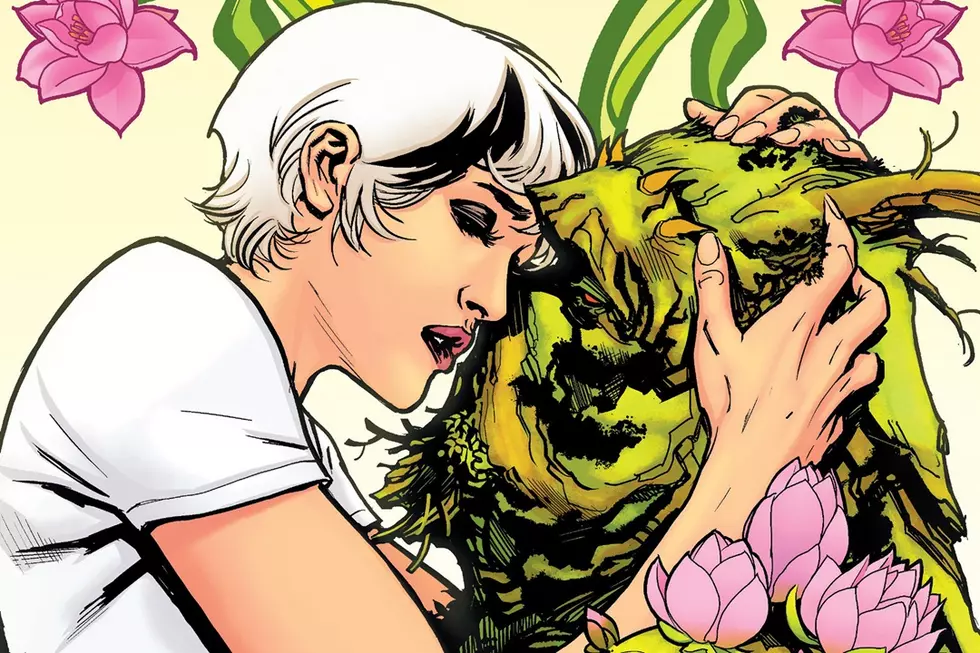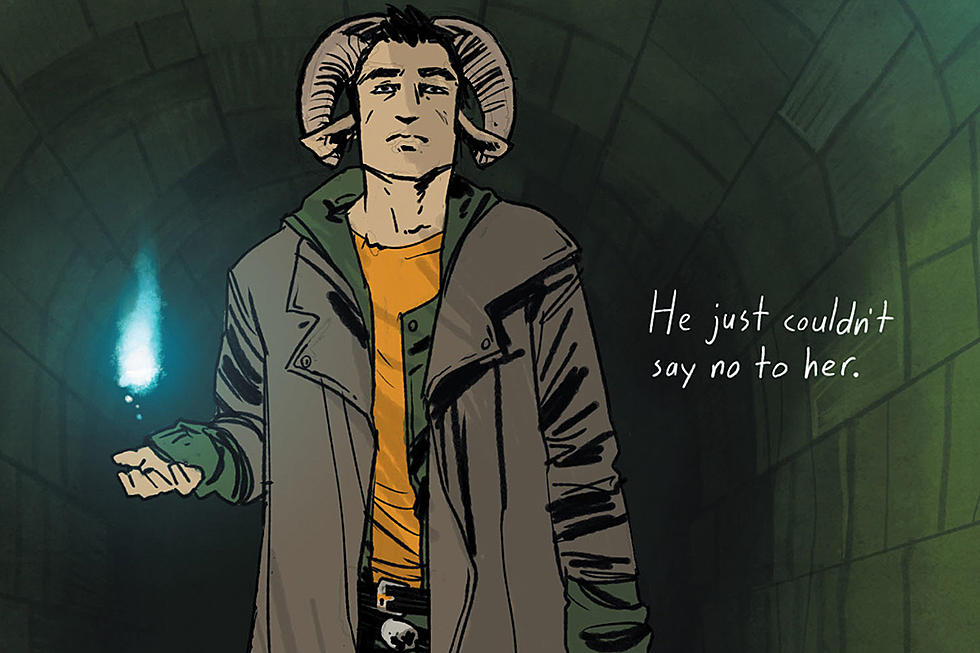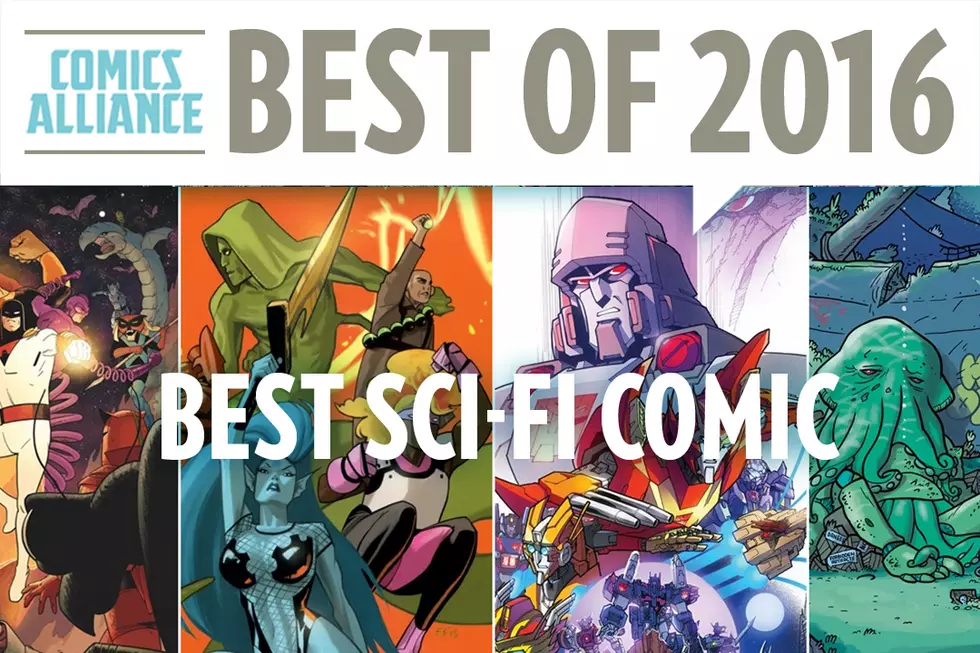![The ‘Saga’ Continues: Catching Up With Brian K. Vaughan & Fiona Staples’ Masterwork [Sci-Fi Week]](http://townsquare.media/site/622/files/2016/09/saga-feat.jpg?w=630&h=420&zc=1&s=0&a=t&q=89&w=980&q=75)
The ‘Saga’ Continues: Catching Up With Brian K. Vaughan & Fiona Staples’ Masterwork [Sci-Fi Week]
When a comic runs for a long while at a consistent level of quality, with a single reliable creative team, it can often slip out of the conversation. When it launched four and a half years ago, Brian K. Vaughan and Fiona Staples' Saga was the talk of the comics town --- a critical darling and one of the crossover hits that helped make Image Comics what it is today.
With the comic now in its seventh volume and approaching its fortieth issue, I decided to revisit Saga and look at how it has changed, and ask whether it still deserves the kind of attention it enjoyed in those early days.
Before we do, it's worth noting that, even as Saga's share of the bookshelf continues to fatten to King Robot proportions, there's no end in sight. While Vaughan stated before it even began that he already knows how the series will end, he's consistently said that there is no cap on how long it will run, comparing the book to the seemingly immortal Walking Dead.
As the book has progressed, that has started to make a lot more sense. We've watched Hazel grow from inciting-incident infant --- the very first issue opens with her birth --- to a walking, talking, bug-torturing child of about five or six.
While Alana and Marko have been the main characters up to this point, it really is believable that Saga could end up not only being Hazel's story --- after all, she has been narrating the book since the very start --- but her entire life story. I guess the clue's right there in the title, but we could be looking at a generations-spanning family saga, something I haven't really seen done in comics, except perhaps in Love & Rockets' Palomar stories.
The comic itself has grown right alongside Hazel. Not only has Staples' art become even more emotive and inventive and just downright tear-this-page-out-and-stick-it-on-your-wall beautiful over the years, the book has frequently drifted away from the original driving force of two star-cross'd parents on the run from their warring factions, to explore the rest of the universe.
The cast has expanded immeasurably, and characters who were introduced as villains are now part of the family. The speed with which Saga manages to endear you to its characters has always been one of its great strengths, right from that very first cliffhanger leaving you rooting for the seemingly doomed lovers, and it has since applied that to pretty much every person we've met along the way --- even the ones who attempted to kill your favourite character a few issues back (and in some cases succeeded).
It's also dipped into other types of story, most notably with volume four, which dialled up the (soap) opera half of the space opera equation. With Alana and Marko --- briefly --- settled into a relatively normal life, the book was able to tell stories on a more domestic level: struggles with co-workers, small temptations and disappointment with work. It's not exactly zipping across the galaxy in a rocket ship made of tree, but the smaller scale of that period, for me at least, brought the stakes closer to home. For all its twists and turns and willingness to kill off really loveable characters, I'm not sure the book has ever broken my heart as much it did with the tale of Alana's drug use and Marko's infidelity, bookended with the line, "This is the story of how my parents split up."
Amidst that constant change, however, Saga has maintained a pretty steady rhythm. Many hallmarks established in the very first issue have remained present throughout: the mix of fantastical (and alternately adorable and disgusting) creature designs from Staples and modern everyday mundanity; the hand-lettered narration, overlaid straight onto the art by Staples herself; the book's even-handed approach to explicit imagery of both a sexual and violent nature, from mass orgies to shredded faces, fellatio to decapitation (the former, naturally, being the part that got Saga into trouble with Comixology).
More than anything, I think the one thing that has helped the book feel coherent for close to forty issues is a simple structural conceit: pretty much every issue opens and closes on a single image splash. It's pretty much a Vaughan trademark at this point, one that he's been developing since the days of Y: The Last Man and Runaways, but Saga sticks to it almost religiously. It gives every issue its own cold open --- an often-contextless image with just a few lines of text to anchor the reader --- and its own cliffhanger, and whether you're reading in singles or collections (which wisely retain the breaks between issues) it gives the series its consistency.
The few times the series has experimented with other ways of opening each issue --- no issue has ever ended with anything but a full-page image --- it felt more jarring than the foray into another genre. Maybe, as they did for me, volumes five and six felt somehow "less Saga" to you. I couldn't put my finger on it at the time, but I think it's down to the three- and four-panel pages that open many of those issues.
As of "The War on Phang" --- the latest volume, and the first to have its own official title, as far as I'm aware --- we're back to business. Marko and Alana have been reunited, and the story is back to their journey across the galaxy and the people pursuing them. The stakes are life-and-death; there are new characters, both cute and monstrous; we've seen a giant turtle spraying blood from its headless neck and a fairly wonderful 2001: A Space Odyssey-style transition from the rocket ship to a page-length erect penis.
And, vitally, both issues so far have opened and closed with striking splash images --- and, in the case of #37, closing for the first time on a double-page spread.
With that solid foundation established, Saga seems ready to explore new ground, thematically speaking (as well as geographically). A number of parallels have been drawn between the titular war and conflicts in our world, with characters discussing the plight of refugees, stories about judging an entire people based on the violent actions of a single representative, and discussions about whether the war might actually be more about the fuel beneath the battlegrounds than any supposed ideals.
They're complex topics but, as the book continues to mature, they're ones that it will be interesting to see Saga tackle.
More From ComicsAlliance


![Comics’ Sexiest Female Characters (From A Queer Perspective) [Love & Sex Week]](http://townsquare.media/site/622/files/2017/02/hg_featured.jpg?w=980&q=75)






